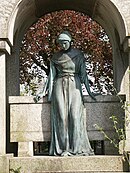Plau am See cemetery
The Plau am See cemetery is the main burial site in Plau am See in the Ludwigslust-Parchim district in Mecklenburg-Western Pomerania . It is a protected architectural monument .
description
The more than 4 hectare cemetery is located west of the city center. The main entrance is on Steinstrasse next to house number 71. With its 480 trees, the cemetery has the character of a natural park cemetery. Most of the tree population is well over 100 years old and consists mainly of linden, ash and maple. You can also find oak, plane trees, birch, red beech and other species. A pedunculate oak has been listed as a natural monument since 1939 . In various areas there are numerous tombs worth preserving, some of which are in need of renovation.
Bird life
A professional ornithological survey of the cemetery area and its immediate surroundings on April 29, 2017 provided evidence of 28 bird species, most of which also belong to the breeding bird population:
- blackbird
- Blue tit / chaffinch
- magpie
- Fitis
- Bullfinch / Girlitz / Greylag goose / Greenfinch
- Black redstart / house sparrow / dunnock
- Grosbeak / Nuthatch / Great Tit
- Black-headed gull
- Blackcap
- Nightingale / hooded crow
- Wood pigeon / robin
- Song thrush / star / goldfinch
- Fieldfare / Treecreeper / Long-eared Owl (observed May 12, 2017) / Golden Grouse
- Wren / Chiffchaff
history
Until 1800, the main burial place of the city of Plau am See existed in the direct vicinity of the Marienkirche . There were other small cemeteries outside the city. Due to centuries of use of the limited area around the church, there were increasing problems with occupancy in the 18th century. On the one hand there were hygienic reasons, on the other hand the population grew continuously. So the decision was made to build a new cemetery, at that time still outside the city walls. This new burial place was consecrated and put into use on September 29, 1800. In 1853, the area was expanded for the first time, and a gravedigger's house was built at the same time. Up to 1893 there were several extensions to the present size.
Progressive changes in the burial culture led, especially after 1990, to the fact that large areas of the cemetery are no longer used for burials.
Tombs worth preserving
| photo | Surname | built | Remarks |
|---|---|---|---|

|
Ernst Alban | (after) 1856 | oldest preserved tomb; manufactured in the Alban's iron foundry; renovated in 1997 |

|
Fam. Daries | ~ 1918 | designed by sculptor Wilhelm Wandschneider , relief stolen in 2016 |

|
Fam. Gast / Köppen | ~ 1914 | |

|
Fam. Gantikow | ~ 1906 | |

|
Fam. Heinrich Haukohl | 1902 | after a design by the sculptor W. Wandschneider; Figure stolen in 2006 |

|
Fam. Otto Haukohl | 1917 | |

|
Fam. Gustav Kern | ~ 1901 | |

|
Fam. Wandschneider | 1890 | |

|
Fam. Viktor Wentzel | ~ 1905 | |

|
Fam. Wilhelm Wilde | 1882 | Cast iron grave fence stolen in 2015 and 2019 |

|
Fam. Ziegenhagen | 1924 | |

|
Zimmermann family | 1923 | |

|
Fam. Friedrich Zülow | 1924 |
Web links
Coordinates: 53 ° 27 ′ 29.5 " N , 12 ° 15 ′ 21.1" E

